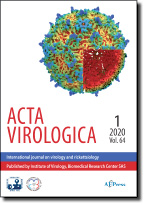Acta Virologica Vol.59, No.2, p.199-203, 2015
|
| Title: Serum total antioxidant capacity status of HTLV-1 infected patients |
| Author: S. SHOMALI, F. Zahedi AVVAL, R. BOOSTANI, L. JARAHI, M. YOUSSEFI |
|
Abstract: Many aspects of the pathogenesis of Human T-cell lymphotropic virus type 1 (HTLV-1) still need further elucidations. Previous studies have indicated that oxidative stress occurs during infection with the other retrovirus, human immunodeficiency virus 1 (HIV-1). Similar results have been observed in some other chronic viral infections including hepatitis B (HBV) and hepatitis C (HCV). In order to reveal possible oxidative stress in HTLV-1-infected patients, we evaluated serum total antioxidant capacity (TAC) as an indicator of oxidative stress in these patients. Forty-four HTLV-1-seropositive individuals were included in this study, consisting of 12 symptomatic and 32 asymptomatic (carrier) cases. Controls consisted of 36 apparently healthy, HTLV-1-, HIV- and hepatitis-seronegative individuals. All symptomatic patients had HTLV-1-associated myelopathy/tropical spastic paraparesis (HAM/TSP). Serum TAC levels in patients and healthy individuals were measured using a quantitative TAC assay. The antioxidant capacity in HTLV-1-seropositive cases was significantly reduced compared to control group (P = 0.001). In addition, TAC was lower in patients with more than 5 years history of HAM/TSP compared to those with ≤5 years duration of the myelopathy (P = 0.03). Our results show a depletion of TAC during HTLV-1 infection, which intensifies along with the disease progress. This finding indicates a role of the oxidative stress in pathogenesis of HTLV-1. These results may prompt further research to evaluate any possible therapeutic effect of antioxidant dietary supplements for HTLV-1 infected individuals.
|
|
| Keywords: HTLV-1; oxidative stress; total antioxidant capacity (TAC) |
|
|
Published online: 22-Jun-2015
|
| Year: 2015, Volume: 59, Issue: 2 |
Page From: 199, Page To: 203 |
doi:10.4149/av_2015_02_199
|
|
 download file download file |
|
|
|
|
 download file
download file
